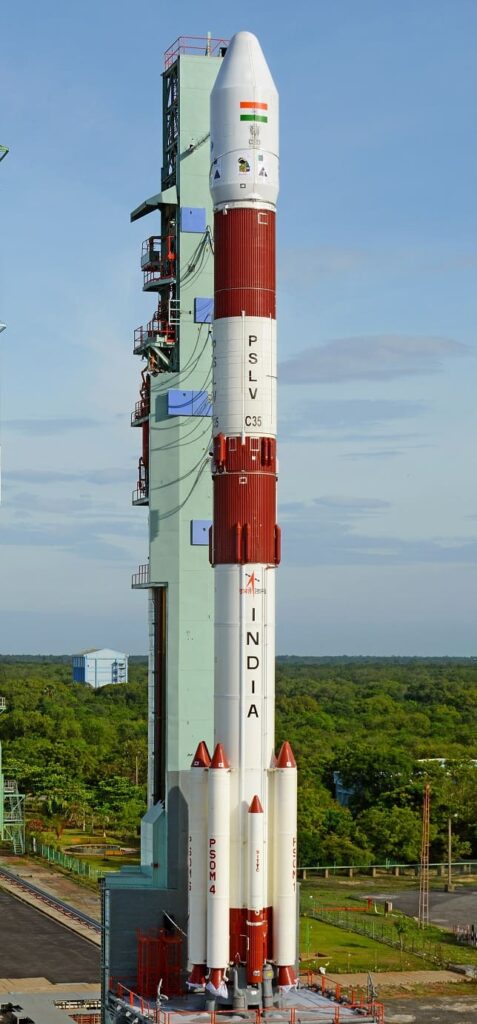What is the Full form of PSLV?
PSLV Full Form is Polar Satellite Launch Vehicle it is the Indian Space Research Organisation, which is a medium-lift launch vehicle that can only be used once (ISRO). It was made so that India could launch its Indian Remote Sensing (IRS) satellites into sun-synchronous orbits. Before the PSLV was made in 1993, Russia was the only country that could do this for money. PSLV can also send small satellites into a place called Geostationary Transfer Orbit (GTO).
As of February 2021, PSLV has sent 342 satellites from 36 different countries into space. The most important of these was the launch of PSLV-C37 on February 15, 2017, which successfully put 104 satellites into sun-synchronous orbit. This tripled the previous record for the most satellites sent into space in a single launch, which had been held by Russia until January 24, 2021.
PSLV Vehicle Description :
The PSLV has four stages that use both solid and liquid systems to move forward.
- The first stage is one of the biggest solid rocket boosters in the world. It holds 138 t (136 long tonnes; 152 short tonnes) of hydroxyl-terminated polybutadiene-bound (HTPB) propellant and has a maximum thrust of about 4,800 kN.
- The second stage is powered by a single Vikas engine and has two tanks with 41.5 t (40.8 long tonnes; 45.7 short tonnes) of liquid propellant that can be stored on Earth. The fuel is unsymmetrical dimethylhydrazine (UDMH) and the oxidizer is nitrogen tetroxide (N2O4). It can push with a force of up to 800 kN.
- The third stage uses 7 t (6.9 long tonnes; 7.7 short tonnes) of solid propellant made of hydroxyl-terminated polybutadiene to make 240 kN of thrust.
- The fourth stage is powered by twin engines that use monomethylhydrazine (MMH) and mixed oxides of nitrogen as fuel (MON).
Launch History of PSLV
As of February 14, 2022, the PSLV has launched 54 times. Of these, 51 have reached their planned orbits successfully, two have completely failed, and one has only partially failed. This gives the PSLV a 94 percent success rate (or 96 percent including partial failure). Before 2002, the Satish Dhawan Space Centre was called the Sriharikota Range. This is where all launches have taken place (SHAR).
| Variant | Launches | Successes | Failures | Partial failures |
| PSLV-G (Standard) | 12 | 10 | 1 | 1 |
| PSLV-CA (Core Alone) | 14 | 14 | 0 | 0 |
| PSLV-XL (Extended) | 23 | 22 | 1 | 0 |
| PSLV-DL | 3 | 3 | 0 | 0 |
| PSLV-QL | 2 | 2 | 0 | 0 |
| Total as of February 2022 | 54 | 51 | 2 | 1 |
Diagram of PSLV :

FAQ ( Frequently Asked Questions )
1. What is PSLV and GSLV?
Ans – Polar Satellite Launch Vehicle (PSLV) and Geosynchronous Satellite Launch Vehicle are India’s two working launchers (GSLV). With its own Cryogenic Upper Stage, the GSLV can launch communication satellites that weigh up to 2 tonnes.
2. WHO launched PSLV?
Ans – PSLV C37 was sent into space from the Satish Dhawan Space Centre in Sriharikota (SHAR) with 104 satellites from 6 countries (Israel, Kazakhstan, Netherlands, Switzerland, United Arab Emirates and the United States).
3. What is the difference between PSLV and GSLV satellite?
Ans – PSLV is made to send earth observation or remote sensing satellites into space, while GSLV is made to send communication satellites into space. GSLV sends satellites into higher elliptical orbits, called Geosynchronous Transfer Orbit (GTO) and Geosynchronous Earth Orbit (GEO) (GEO).
4. Where is Aryabhata satellite now?
Ans – After 5 days, the spacecraft stopped sending any signals. The satellite came back down to Earth on February 11, 1992.
5. How many rockets has India launched?
Ans – From the launch of India’s first satellite, Aryabhatta, in 1975 to the launch of EOS-04 in 2022, India has sent over 120 satellites into space.

